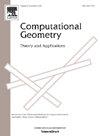最大化有序最近邻图的最大度
IF 0.7
4区 计算机科学
Q4 MATHEMATICS
Computational Geometry-Theory and Applications
Pub Date : 2025-09-18
DOI:10.1016/j.comgeo.2025.102229
引用次数: 0
摘要
对于欧几里得空间中的有序点集,或者更一般地说,在抽象度量空间中,通过有向边将每个点与其最近的前导点连接起来,得到有序近邻图。我们证明了对于Rd中每一个n个点的集合,存在一个阶使得相应的有序近邻图的最大度至少为log (n/(4d))。除了1/(4d)因素,这个边界是最好的可能。对于抽象设置,我们证明了对于每一个n元素度量空间,存在一个阶,使得相应的有序近邻图具有最大度Ω(log log n/log log log n)。本文章由计算机程序翻译,如有差异,请以英文原文为准。
Maximizing the maximum degree in ordered nearest neighbor graphs
For an ordered point set in a Euclidean space or, more generally, in an abstract metric space, the ordered Nearest Neighbor Graph is obtained by connecting each of the points to its closest predecessor by a directed edge. We show that for every set of n points in , there exists an order such that the corresponding ordered Nearest Neighbor Graph has maximum degree at least . Apart from the factor, this bound is the best possible. As for the abstract setting, we show that for every n-element metric space, there exists an order such that the corresponding ordered Nearest Neighbor Graph has maximum degree .
求助全文
通过发布文献求助,成功后即可免费获取论文全文。
去求助
来源期刊
CiteScore
1.60
自引率
16.70%
发文量
43
审稿时长
>12 weeks
期刊介绍:
Computational Geometry is a forum for research in theoretical and applied aspects of computational geometry. The journal publishes fundamental research in all areas of the subject, as well as disseminating information on the applications, techniques, and use of computational geometry. Computational Geometry publishes articles on the design and analysis of geometric algorithms. All aspects of computational geometry are covered, including the numerical, graph theoretical and combinatorial aspects. Also welcomed are computational geometry solutions to fundamental problems arising in computer graphics, pattern recognition, robotics, image processing, CAD-CAM, VLSI design and geographical information systems.
Computational Geometry features a special section containing open problems and concise reports on implementations of computational geometry tools.

 求助内容:
求助内容: 应助结果提醒方式:
应助结果提醒方式:


